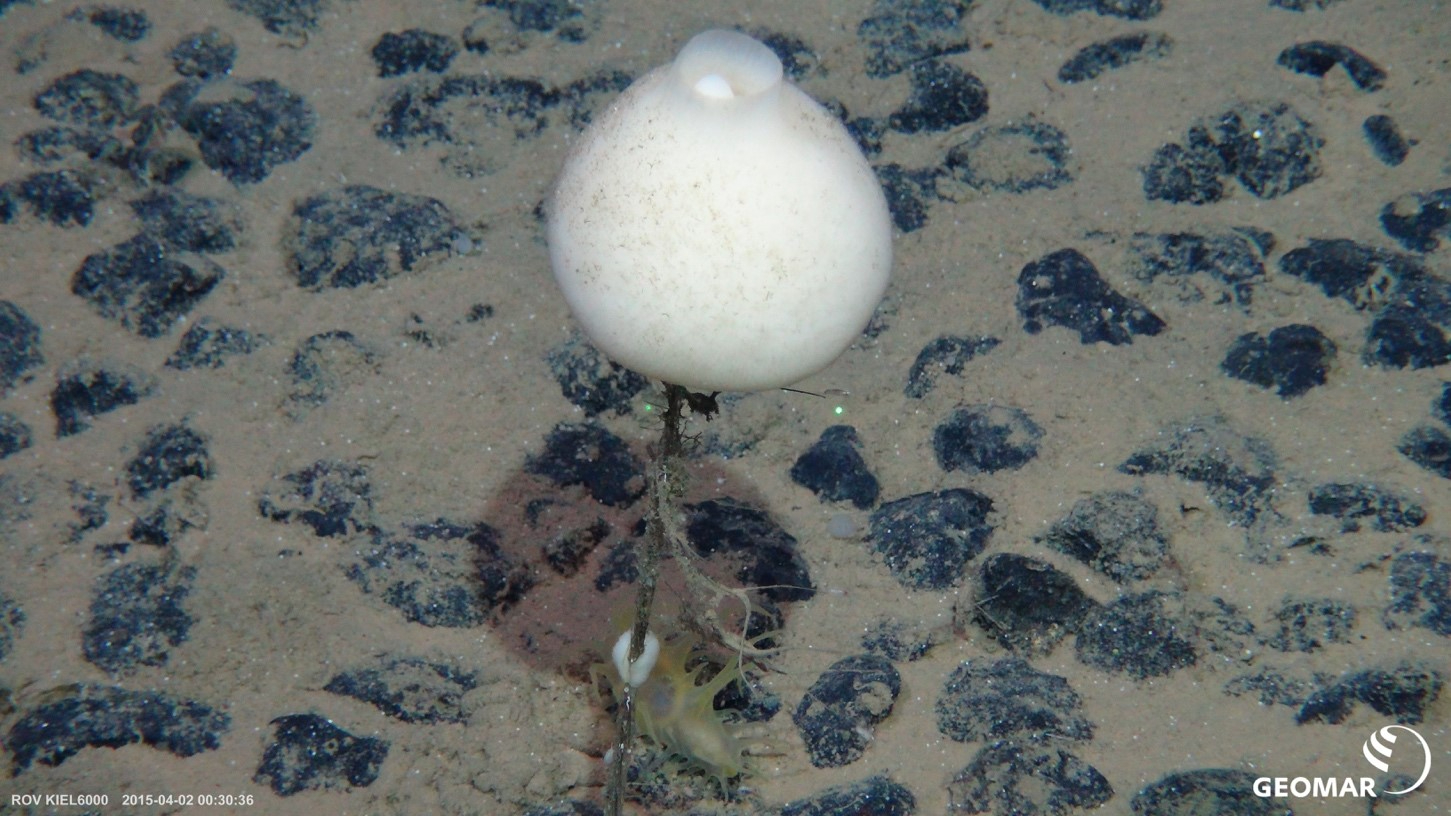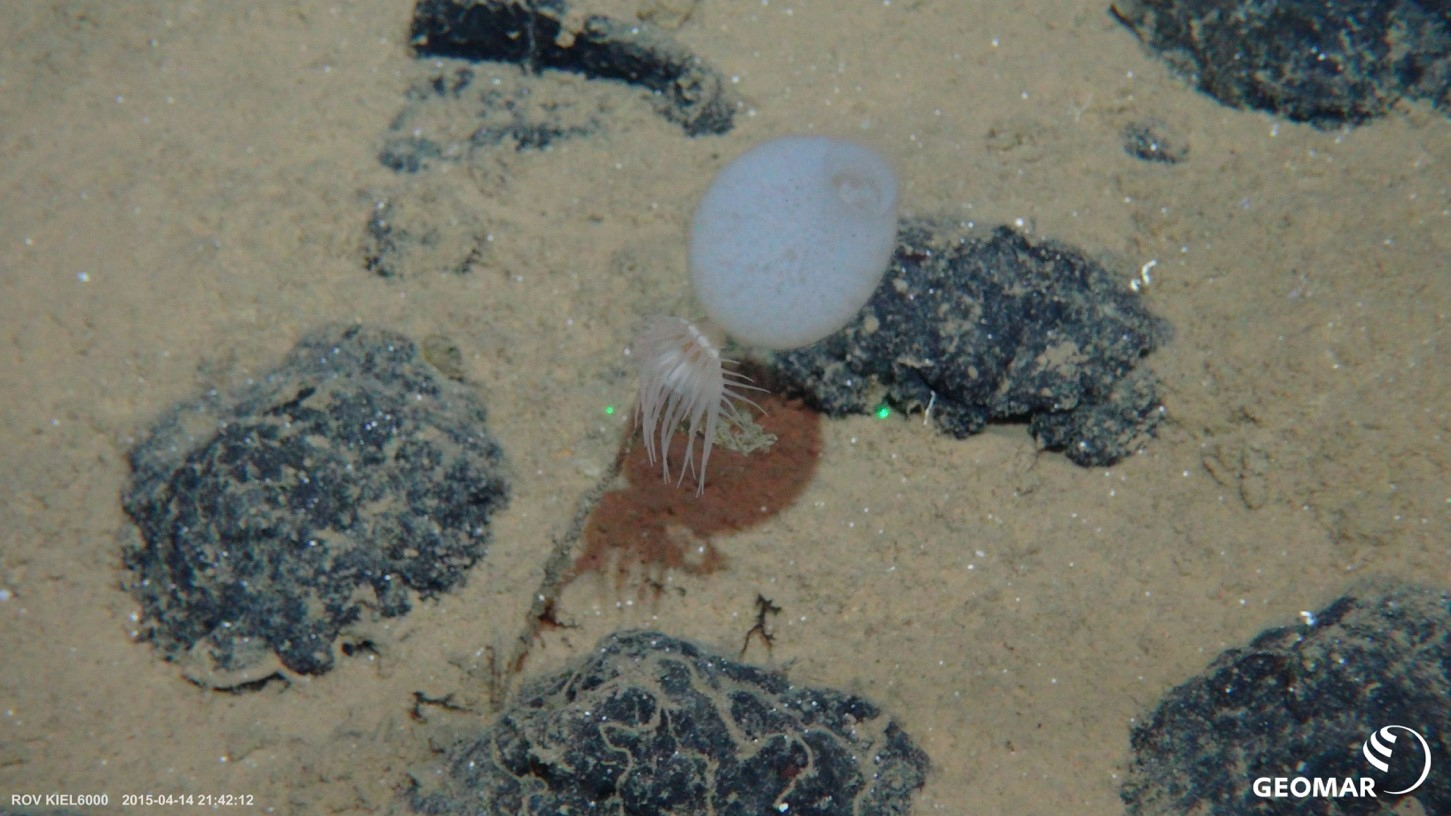Sponges on valuable nodules enable high biodiversity ocean floor
Deep down on the ocean floor covering many thousands of square kilometers of the world's deep-sea floor, manganese nodules are present containing the valuable raw materials cobalt, nickel, tin and copper. These polymetallic nodules, that take millions of years to become roughly the size of a potato, are of great economic interest: they are used to meet our increasing demand for rare metals used in smartphones, electric cars and other technology. However, the nodules form the basis of a complex ecosystem that we still barely know and understand. Although to date, there is no market-ready technology for deep-seabed mining from the 4 km deep seabed, it is clear that such interventions will have a massive and lasting impact on the areas affected.

Complex network of interactions
This is also confirmed by a study now published by marine biologist Tanja Stratmann, previously from the NIOZ Royal Netherlands Institute for Sea Research, and now affiliated to Utrecht University and the Max Planck Institute for Marine Microbiology in Bremen, Germany, and by scientists from NIOZ and the Senckenberg am Meer Institute in Wilhelmshaven, Germany.
In their study, Stratmann and her colleagues used data from a variety of existing surveys as well as deep seafloor imagery from two regions of the Pacific Ocean that are rich in manganese nodules. Using these data, they reconstructed the complex network of interactions between organisms and the nodules that are essential for the integrity of this ecosystem. The connecting link between them are so-called glass sponges that grow on 10 cm long stalks.
Cascading effect on animal species
“We discovered that the fact that stalked sponges often attach to polymetallic nodules is an essential interaction within the network”, Stratmann explains. The sponges use the hard nodules amid the muddy deep-sea environment as the only available hard substrate. With their stalks, they anchor themselves to the nodule while their main body protrudes into the water to filter tiny particles from it. Moreover, the sponges themselves provide a habitat for other animals, such as small worms, crabs and clams. “Our models predict that if nodules are removed, most sponges will also disappear, and with them the associated fauna”, Stratmann adds. “This has a cascading effect and reduces the number of animal species and links in the food web. Without the nodules, the food web in the deep sea becomes simpler and less diverse.”
Half of deep-sea inhabitants depend on nodules
Stratmann and her colleagues examined two nodule-rich regions in the Pacific Ocean: the Clarion-Clipperton Zone and the Peru Basin. In both regions, a modelled removal of the nodules massively disturbed the ecosystem. This primarily resulted from ecological interactions between different animals that are not related to feeding. These include interactions between the sponges and the animals that live on them, as well as between the sponge inhabitants themselves. In the Clarion-Clipperton Zone in particular, more than half of the deep-sea inhabitants depend on the nodules in one way or another.
Removal of the nodules and thus the sponges, as would be the case through deep-sea mining, would trigger a cascade of negative effects on the ecosystem. Rapid recovery is unlikely because the nodules take millions of years to grow to substantial size, and the deep-sea ecosystem regenerates very slowly.
Deep down on the ocean floor covering many thousands of square kilometers of the world's deep-sea floor, manganese nodules are present containing the valuable raw materials cobalt, nickel, tin and copper. These polymetallic nodules, that take millions of years to become roughly the size of a potato, are of great economic interest: they are used to meet our increasing demand for rare metals used in smartphones, electric cars and other technology. However, the nodules form the basis of a complex ecosystem that we still barely know and understand. Although to date, there is no market-ready technology for deep-seabed mining from the 4 km deep seabed, it is clear that such interventions will have a massive and lasting impact on the areas affected.
Complex network of interactions
This is also confirmed by a study now published by marine biologist Tanja Stratmann, previously from the NIOZ Royal Netherlands Institute for Sea Research, and now affiliated to Utrecht University and the Max Planck Institute for Marine Microbiology in Bremen, Germany, and by scientists from NIOZ and the Senckenberg am Meer Institute in Wilhelmshaven, Germany.
In their study, Stratmann and her colleagues used data from a variety of existing surveys as well as deep seafloor imagery from two regions of the Pacific Ocean that are rich in manganese nodules. Using these data, they reconstructed the complex network of interactions between organisms and the nodules that are essential for the integrity of this ecosystem. The connecting link between them are so-called glass sponges that grow on 10 cm long stalks.
Cascading effect on animal species
“We discovered that the fact that stalked sponges often attach to polymetallic nodules is an essential interaction within the network”, Stratmann explains. The sponges use the hard nodules amid the muddy deep-sea environment as the only available hard substrate. With their stalks, they anchor themselves to the nodule while their main body protrudes into the water to filter tiny particles from it. Moreover, the sponges themselves provide a habitat for other animals, such as small worms, crabs and clams. “Our models predict that if nodules are removed, most sponges will also disappear, and with them the associated fauna”, Stratmann adds. “This has a cascading effect and reduces the number of animal species and links in the food web. Without the nodules, the food web in the deep sea becomes simpler and less diverse.”
Half of deep-sea inhabitants depend on nodules
Stratmann and her colleagues examined two nodule-rich regions in the Pacific Ocean: the Clarion-Clipperton Zone and the Peru Basin. In both regions, a modelled removal of the nodules massively disturbed the ecosystem. This primarily resulted from ecological interactions between different animals that are not related to feeding. These include interactions between the sponges and the animals that live on them, as well as between the sponge inhabitants themselves. In the Clarion-Clipperton Zone in particular, more than half of the deep-sea inhabitants depend on the nodules in one way or another.
Removal of the nodules and thus the sponges, as would be the case through deep-sea mining, would trigger a cascade of negative effects on the ecosystem. Rapid recovery is unlikely because the nodules take millions of years to grow to substantial size, and the deep-sea ecosystem regenerates very slowly.
Publication
Tanja Strattmann, Karline Soetaert, Daniel Kersken, Dick van Oevelen. Polymetallic nodules are essential for food-web integrity of a prospective deep-seabed mining area in Pacific abyssal plains. Scientific Reports, June 2021. DOI: https://doi.org/10.1038/s41598-021-91703-4

Sponzen op mangaanknollen maken hoge biodiversiteit op de oceaanbodem mogelijk
Onderzoekers van NIOZ en Duitsland hebben ontdekt dat sponzen, die zich graag vestigen op metalen knollen op de oceaanbodem, ook een leefplek vormen voor veel andere dieren. Zonder de sponzen zou de soortenrijkheid in diepzeegebieden significant lager zijn, melden de onderzoekers op 10 juni in het wetenschappelijke tijdschrift Scientific Reports.
Verspreid over vele duizenden vierkante kilometers oceaanbodem zijn mangaanknollen aanwezig met daarin de waardevolle grondstoffen kobalt, nikkel, tin en koper. De knollen, die er miljoenen jaren over doen om de grootte van een aardappel te bereiken, hebben een grote potentiële economische waarde: ze kunnen worden gebruikt om aan onze groeiende vraag naar deze metalen te voldoen om daarmee batterijen en apparatuur zoals smartphones en elektrische auto’s te ontwikkelen. Maar de knollen zijn ook de basis voor een complex ecosysteem waar we nog maar weinig van begrijpen. Op dit moment is de technologie nog niet voldoende ontwikkeld om winning vanaf de meer dan 4 km diepe zeebodem mogelijk te maken, maar het is duidelijk dat zulke activiteiten enorme en blijvende impact zouden hebben op de gebieden.
Complex netwerk van interacties
Dat wordt ook bevestigd in een studie die nu is gepubliceerd door mariene bioloog Tanja Stratmann, voormalig onderzoeker bij het Koninklijk Nederlands Instituut voor Onderzoek der Zee en tegenwoordig verbonden aan de Universiteit Utrecht en het Max Planck Instituut voor Mariene Microbiologie in Bremen, Duitsland. Ze werkte samen met onderzoekers van NIOZ en het Senkenberg am Meer Instituut in Wilhelmshaven, Duitsland.
In hun onderzoek gebruikten Stratmann en haar collega’s gegevens uit verschillende eerdere onderzoeken en diepzeefoto’s uit twee regio’s in de Grote Oceaan die rijk zijn aan mangaanknollen. Met de data reconstrueerden ze de complexe netwerken van interacties tussen organismen en de knollen die het ecosysteem in stand houden. Een verbindende factor bleken de zogeheten glassponzen te zijn, die op een zelfgemaakt steeltje groeien van zo’n 10 cm.
Sneeuwbaleffect op diersoorten
“Het hechten van deze gesteelde sponzen aan metaalknollen blijkt een essentiële link in het netwerk te zijn”, legt Stratmann uit. De sponzen gebruiken de knollen om zich met hun steeltjes te verankeren aan een knol terwijl het belangrijkste deel van hun lichaam minuscule deeltjes uit het water filtert. Zelf vormen de sponzen een belangrijke leefplek voor andere dieren zoals kleine wormen, krabben en schelpdieren. “Onze modellen voorspellen dat als de knollen verwijderd worden, de meeste sponzen zullen verdwijnen en met hen, ook de fauna die van hen afhankelijk is”, vult Stratmann aan. “Dit heeft een sneeuwbaleffect en verlaagt het aantal diersoorten en connecties in het voedselweb. Zonder de knollen is het voedselweb in de diepzee daarmee minder divers.”
Helft van diepzeebewoners afhankelijk van knollen
Stratmann en haar collega’s onderzochten twee gebieden in de Grote Oceaan die rijk zijn aan knollen: de Clarion-Clipperton Zone en de Peru Zone. Voor beide regio’s bleek uit hun modellen dat het verwijderen van knollen het ecosysteem enorm schaadt. De belangrijkste oorzaak daarvan zijn de ecologische interacties tussen verschillende diersoorten, zoals dieren die gebruik maken de spons-steeltjes om iets boven de bodem uit te komen om voedsel uit het water te vangen. Vooral in de Clarion-Clipperton Zone is meer dan de helft van de diepzeesoorten op enige manier afhankelijk van knollen, waarvan een groot deel met de sponzen als intermediair.
Model weerspiegelt effect op soorten
Onderzoeker bij NIOZ Dick van Oevelen benadrukt het belang van de publicatie: “Een paar jaar geleden hadden we al gezien dat de sponzen prominent aanwezig zijn op mangaanknollen. Met dit huidige onderzoek hebben we het belang van sponzen kwantitatief kunnen maken. Het netwerk van afhankelijkheidsrelaties tussen soorten stelden we vast op basis van literatuur en bestaande kennis en daarvan maakten we ons model. Daarmee kun je simuleren wat er gebeurt als één soort of onderdeel uit het netwerk wegvalt.”
Diepzeemijnbouw - het verwijderen van de knollen – zou betekenen dat sponzen verdwijnen en daarmee een negatief effect hebben op het hele ecosysteem. Snel herstel is onwaarschijnlijk, want de groei van een knol duurt miljoenen jaren en het diepzee-ecosysteem herstelt zeer langzaam. Van Oevelen: “De resultaten voor de twee onderzochte gebieden zijn opvallend vergelijkbaar. Dat is echt een aanwijzing voor het effect dat je zou zien als je die knollen weghaalt.”
Publication:
Tanja Stratmann, Karline Soetaert, Daniel Kersken, Dick van Oevelen. Polymetallic nodules are essential for food-web integrity of a prospective deep-seabed mining area in Pacific abyssal plains. Scientific Reports, June 2021. DOI: https://doi.org/10.1038/s41598-021-91703-4